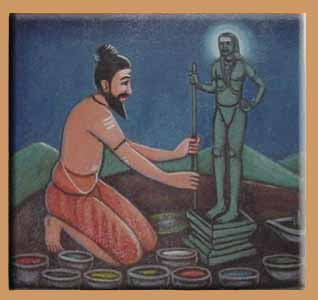 |
| Bogar making herbal idol of god Muruga, Palani, TN navabhasanasiddhar.50webs.com |
 |
| Palani temple hill, TN indianetzone.com |
 |
| Siddha dvashram.com |
Of the 64 poisonous substance, Boggar chose nine poisonous herbs to make navapashanam. The nine available poisonous substances that were normally used to make the beads, malai and idols were Veeram, Pooram, Rasam, Jathilingam, Kandagam, Gauri pasanam, Vellai Pasanam, Mridharsingh and Silasat. The nine poisons represent nine planets and nine openings in our body. Bogar carefully processed using his knowledge of Tantric tradition, the herbs along with others and removed the poison as much as possible enough for humans to keep them alive. Now, it is a powerful alchemy, a smidgen of it is enough to cure any diseases. So, the moovalar idol in saintly posture with a thandam (pole) in his hand is made of hardened wax-like paste of various herbs - navapashanam. It is not a stone image. Nor is it a metal image. It was so tough, anointing (ritual washing of Hindu idols) for long period of time won't cause any wear and tear. The anointed water, milk, etc on the moolavar idol used to be safely collected to be given to the devotees as remedy for many ailments.
 |
| Agasthiyar Left, Bogar (right) shrine. members.tripod.com |
It is said the slim idol of Karthkaya stood unaffected by the effect of abhishekams/ anointing for centuries. On certain festival days like Karttikai, hundreds of abhishekams are done on the idol for the benefit of devotees who would use the anointed water or milk, etc. It it were not flint-hard, the herbal idol would have worn out centuries ago. Sage Bhogar, long ago, created a scientific wonder that may defy our imagination for, it has withstood the test of time beyond our comprehension. The abhishekam materials including the sandalwood paste at night would absorb the medicinal properties on the idol and they cure many ailments. Leucoderma and asthma. It is believed to be a remarkable Siddha elixirs or medicinal potion that will protect 9 important parts in our body. You may call it panacea!! In order to help the people free from some incurable ailments, Bogar made this medicinal potion. God Karthikaya himself advised Bogar to make the idol in a particular fashion and he revolved it to the sage in his dream. An interesting fact is the temple priests (Sivacharyas) of Palani Murugan temple were said to have been the descendants of Pulipani, one of Bogar's students, until the sixteenth century.
This medicinal potion believed to influence 01. Five koshas, 02. Navagrahas and 03. the Panchaboothas in human body. It nullifies the bad effect of some planetary positions on humans, it is said. That a single medicinal preparation offers remedy to so many diseases is a rare thing and this fact that can never be denied.
 |
| Entrance atop the hill (1500' tall), Palani temple. holidayiq.com |
https://www.hinduismtoday.com/modules/smartsection/item.
http://palani.org/navabhasana.html
https://navrangindia.blogspot.com/2018/06/25-interesting-facts-of-yogi-bogars.html
http://palani.org/navabhasana.htm









